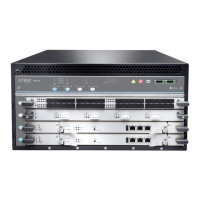the power cables (the cable lugs are supplied with the router). For power cable
specifications, see “DC Power Cable Specifications for the MX240 Router” on page 160.
To connect the DC source power cables to the router for each power supply:
1. Switch off the dedicated customer site circuit breakers. Ensure that the voltage across
the DC power source cable leads is 0 V and that there is no chance that the cable
leads might become active during installation.
2. Attach an ESD grounding strap to your bare wrist and connect the strap to one of the
ESD points on the chassis.
3. Switch the DC circuit breaker on the power supply faceplate to the off (0) position.
4. Remove the clear plastic cover protecting the terminal studs on the faceplate.
5. Verify that the DC power cables are correctly labeled before making connections to
the power supply. In a typical power distribution scheme where the return is connected
to chassis ground at the battery plant, you can use a multimeter to verify the resistance
of the –48V and RTNDC cables to chassis ground:
•
The cable with very large resistance (indicating an open circuit) to chassis ground
is –48V.
•
The cable with very low resistance (indicating a closed circuit) to chassis ground is
RTN.
CAUTION: You must ensure that power connections maintain the proper
polarity. The power source cables might be labeled (+) and (–) to indicate
their polarity. There is no standard color coding for DC power cables. The
color coding used by the external DC power source at your site determines
the color coding for the leads on the power cables that attach to the
terminal studs on each power supply.
6. Remove the nuts and washers from the terminal studs. (Use a 7/16-in. [11 mm] nut
driver or socket wrench.)
7. Secure each power cable lug to the terminal studs, first with the flat washer, then
with the nut (see Figure 74 on page 204). Apply between 23 lb-in. (2.6 Nm) and 25 lb-in.
(2.8 Nm) of torque to each nut. Do not overtighten the nut. (Use a 7/16-in. [11 mm]
torque-controlled driver or socket wrench.)
a. Secure each positive (+) DC source power cable lug to the RTN(return) terminal.
b. Secure each negative (–) DC source power cable lug to the 48V (input) terminal.
Copyright © 2017, Juniper Networks, Inc.202
MX240 3D Universal Edge Router Hardware Guide

